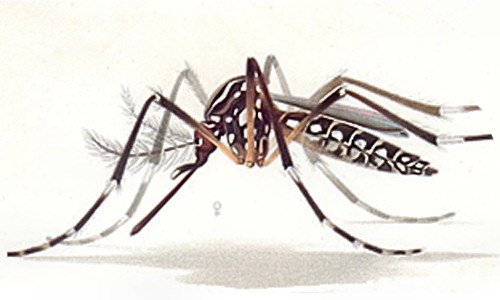Dengue fever, an infectious tropical disease found in more than 100 countries, has no cure and no vaccine. One reason why it has been difficult to develop new drugs for dengue fever is that there are no good animal models of the disease, which only infects humans.
To help overcome that, researchers from MIT and the Singapore-MIT Alliance for Research and Technology (SMART) have produced a “humanized mouse” that mimics many features of the human immune system. These mice can be infected with dengue virus, allowing researchers to observe how the infection progresses and identify possible drug targets.
In a recent paper, the team discovered the cause of one of the major symptoms of dengue fever — the depletion of blood platelets, which are essential to proper blood clotting. The finding could help scientists come up with new ways to treat dengue, says Jianzhu Chen, the Ivan R. Cottrell Professor of Immunology at MIT, a member of MIT’s Koch Institute for Integrative Cancer Research, leader of the SMART Infectious Disease Interdisciplinary Research Group, and senior author of the paper.
Dengue fever is a mosquito-borne illness that infects at least 50 million people worldwide each year. About 80 percent of those people have no symptoms or mild symptoms, but the more severe form of the disease hospitalizes about 500,000 people per year.
The virus infects cells of the human immune system, leading to symptoms that include liver damage and loss of white blood cells. In severe cases, blood plasma leaks out of the circulatory system and collects in body cavities, which can be fatal.
In the new study, which appears in the Journal of Virology, the researchers set out to study one of dengue fever’s common effects — the depletion of blood platelets, which are necessary for blood clotting. Losing those platelets may contribute to plasma leakage, Chen says.
Previous efforts to study this phenomenon in mice have failed because the mice could not be induced to generate human blood platelets. The MIT team not only created mice that could produce human platelets, they also saw that those platelets were dramatically depleted following infection with dengue virus.
Two theories have been proposed to explain platelet depletion. One is that in some people, antibodies activated by the viral infection also attack their own platelets. The other theory is that the infection somehow interferes with platelet production, which occurs in the bone marrow.
The MIT team found two pieces of evidence to support the second theory. First, their mice lost human platelets even though they did not produce a strong antibody response to the virus. Second, the researchers found that in the bone marrow, cells that eventually become platelets, known as megakaryocytes, were also depleted.
“This points out that development of platelets in bone marrow is the cause of platelet depletion in the humanized mice. It could be the cause in humans as well, but that has to be confirmed,” Chen says.
This is the first time that scientists have been able to generate human platelets in mice to study dengue fever, Chen says. The researchers induced the mice to produce human platelets by implanting them with a type of stem cells known as CD34+ cells, which come from the liver and can develop into either mature liver cells or blood cells.
After being implanted in the mice, these cells began producing a growth factor, known as thrombopoietin, which is important for platelet generation. That factor encouraged human blood cell precursors in the bone marrow to become platelets.
“The study represents a major breakthrough in establishing a small-animal model for understanding dengue disease in humans,” says Pei-Yong Shi, executive director for disease biology at the Novartis Institute for Tropical Diseases in Singapore, who was not part of the research team. “The new humanized mouse model reported in the current study robustly captures the symptom of platelet loss; therefore, the model has provided a unique system to study the [underlying] mechanism.”
The researchers now plan to try to generate the more severe form of dengue infection, which they did not see in this study. They also hope to use the mice to test antiviral compounds that have been developed as potential drugs to treat dengue fever.
Story Source:
The above story is reprinted from materials provided by MIT News Office, Anne Trafton.





